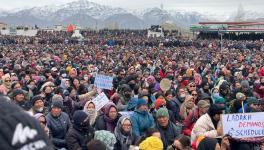Ladakh Region Demands a Major Disruption in the Process of Engagement

Image Courtesy: Wallpaper Flare
In July 2022, a column on this website was titled “Act Now Before It’s Too Late”. It is nearly a year now, and the situation, instead of improving, has further worsened in Ladakh.
Since then, there have been demonstrations and protests by the people of Ladakh. A five-day hunger strike was led by a tribal leader, Sonam Wangchuk, on two major issues, special status under Schedule VI to the region and the climate change impact faced by the native communities. This hunger strike triggered massive protests. Sit in dharnas, mass-level hunger strikes, and so on by common people and even religious congregations of Buddhists and Muslims.
Later, in February 2023, a strong demonstration was held at Delhi, Jantar Mantar, where a large section of Ladakhis joined.
Meanwhile, a new lieutenant governor with a military background was appointed. Things have still not rolled as per the desired wish of the ruling establishment in Delhi. Now, Delhi controls the Union Territory of Ladakh after the abolition of Article 370 and the de-merger of the region from the erstwhile state of Jammu and Kashmir.
August 2019, there was jubilation in the Ladakh region as they thought breaking the triangle from Leh to Srinagar, Srinagar to Delhi, and then back to Leh was welcome as it was cumbersome. Instead, a straight line from Leh to Delhi will give the region a great fillip in its developmental trajectory.
However, little did the region's residents realise that the withdrawal of Article 35 A would bereave them of their safeguards in the erstwhile state. Take, for example, preference for government jobs, appointment procedures, etc. To date, one of the major concerns that the Ladakhis have is that there is no public service commission or a subordinate selection board for appointments in different departments.
The current movement in Ladakh is a joint initiative of the Kargil Democratic Alliance(KDA) and Leh Apex Body(LAB) that comprises not just political groups and parties but also trade unions and social and religious groups.
Major Demands
In discussion with the writer, Sajjad Kargili, leader of the KDA who had visited Delhi to meet the minister of the state along with a delegation of KDA and LAB, he dwelled on the four major demands being raised in the region. He said they are hopeful that a dialogue process would at least start.
∙ Demand for 6th Schedule status is gaining ground in the region. This has become a major mobilising force of the Ladakhis. As Sajjad explained, “Few announcements have been made in the past that thousands of hectares of land will be given to the corporates in the Ladakh region. This has created unrest amongst the people. More than 90% of the population is tribal and deserve their land and culture to be protected.” According to Schedule 6 of the Indian Constitution, the areas under administration are Assam, Nagaland, Tripura, and Mizoram. They are administered as Autonomous Regions and Autonomous Districts. The Ladakh region demands such secure autonomy to their region.
∙ Opening of a permanent public service commission: It is quite surprising that since 2019, after the detachment of the region from Jammu and Kashmir, there has not been any employment of the local youth in the gazetted and non-gazetted sections. This has also created a fear of jobs being doled out to non-Ladakhis and the locals feeling the pinch of unemployment.
∙ A Legislature and Increased Political Representation: An inherent dichotomy developed as soon as the union territory assumed office in the region. The current political setup comprises the two hill councils, Leh and Kargil. Before this, there was one member of parliament in Lok Sabha, which continues, and a bunch of MLAs from the region. At least two ministers would be in the erstwhile Jammu and Kashmir state. However, currently, the empowerment of the people through their elected institutions is dwarfed, if not completely gone. Take, for example, the budget provisions. The two hill councils have a combined budget of not more than Rs 700 crore, whereas the bureaucrat-driven UT administration comprising a few Indian Administrative Service (IAS) officers is more than Rs 5,500 crore. The native people are hardly taken into consideration in the spending of this money. Hence the second major demand is for declaring Ladakh a state with a legislature and one more MP for the Lok Sabha.
∙ Filling over 12,000 posts in different categories based on the old state subject laws previously in place, ensuring reservation to the local population.
Those who attended the meeting on June 19, 2023, with the minister of state(Home), Nityanand Rai, include three representatives from the Leh Apex Body - Thupstan Chhewang, a two-time Lok Sabha member from Ladakh, Chering Dorjey and Nawang Rigzin Jora, both former cabinet ministers in erstwhile Jammu and Kashmir state, and from the Kargil Democratic Alliance, Qamar Ali Akhoon, a former cabinet minister in previous J&K government, Haji Asgar Ali Karbalaie, ex MLA and Sajjad Kargili, a prominent social-political activist from Kargil.
Problems Beyond Their Scope of Mitigation
Meanwhile, the region is grappling with problems beyond the imagination and their capacity to address them.
For example, the massive influx of tourists visiting the region during the summer and autumn months. Whereas this is one of the major sources of income for the local population, it also brings in the perils of mass tourism. Solid waste management is a big challenge left out to the hill and municipal councils. Even if they can collect the waste, the quality of the waste is such that they can hardly do anything with it.
In a recent ‘waste audit’ conducted by the Integrated Mountain Initiative (IMI) in Leh, it was found that of the total waste collected, 75 % of it is neither biodegradable nor recyclable. What is to be done with such waste, produced elsewhere in the country but brought in the Leh and dumped in the hills?
Likewise, it was interesting to note that of the 10 largest polluters, 8 were multinational corporations. Extended Producer Responsibility(EPR) laws are hardly applicable in Leh and Kargil regions. The waste is increasing with some clearance of it, but then again, new waste is being added every day.
Water pollution in Leh town is rampant. Nearly 95% of the water sources are estimated to be polluted because of the transformation from dry pit toilets to water flush toilets. For drinking purposes, water must be pumped from the Indus River.
The evident impact of climate change is being witnessed by the Ladakhis, with hardly any assessment of risks and investment in adaptability measures. Even the development plan made for the Leh region is another copy-paste model of the plains, which will further accentuate the region's problems.
The liner line of connection from Leh to New Delhi was considered a panacea for the problems of the people living in Ladakh. However, things have only worsened with the New Delhi model of technological interventions and bypassing the role of the people in deciding their own futures.
The talks held in Delhi must continue to another round of engagement, ensuring the people are kept at the centre of planning and deciding their futures.
The writer is the former deputy mayor of Shimla. Himachal Pradesh. The views are personal.
Get the latest reports & analysis with people's perspective on Protests, movements & deep analytical videos, discussions of the current affairs in your Telegram app. Subscribe to NewsClick's Telegram channel & get Real-Time updates on stories, as they get published on our website.
























